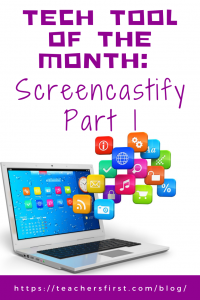Screencastify is a Chrome browser extension that you can use to create quick and easy screencasts — recordings of your screen you can use to demonstrate class instructions, introduce yourself to students, create videos for a substitute, enhance remote learning lessons, and so much more. Students can even create their own screencasts to show what they know or to offer an alternative to a traditional oral report. The free version of Screencastify allows you to record an unlimited number of five-minute videos and includes plenty of recording options, like no watermarks, the ability to trim videos, annotation tools, and easy ways to publish to YouTube. This tool will even autosave videos to your Google Drive account! Don’t miss the For School tab full of blogs, classroom ideas for using screencasts, and much more.
Applying the Triple E Framework
The Triple E Framework, created by Dr. Liz Kolb, is built on the belief that “effective technology integration begins with good instructional strategies and not fancy tools” (tripleeframework.com). Dr. Kolb wrote a book on the topic, Learning First, Technology Second (ISTE, 2017), that lays out the three main uses for technology in education: to Engage, Enhance, or Extend learning goals. We can use this framework to decipher why we are using specific tools in the classroom. Here is a rubric based on the Triple E Framework you can use to evaluate whether Screencastify (or any other technology) is a good fit with your learning goals and whether you should use it in your lesson.

- Engage in learning goals: Screencastify offers minimal distractions so the main focus remains on the learning goals. Students are able to work at their own pace and even re-watch a screencast if they don’t fully understand after the first viewing. This Google Chrome extension motivates students to begin the learning process, as they are able to view instructional screencasts created by others or create their own screencasts to show what they know.
- Enhance learning goals: This tool enhances learning goals by allowing teachers to scaffold the information into smaller, more digestible chunks for students to process at their own pace. Since the time limit is five minutes, each screencast is short and quick to re-watch. Students use both creativity and higher-order thinking skills to organize their thoughts when creating their own screencasts. Students also have the option to re-record the final screencast if they wish to improve their presentation.
- Extend learning goals: Dr. Kolb describes extended learning as an opportunity for students to learn, connect, and collaborate outside of the regular school day and as a bridge between the school day and real-life experiences. Screencastify is a great tool to use when you are blending a lesson or teaching remotely. This is a very simple way to show content, demonstrate a new web tool, and introduce yourself to the class. The videos can be viewed (and created) in the classroom, at home, during a study hall, or anywhere that the student is working. We’re preparing our students for a world that doesn’t exist yet, but most jobs require independent motivation and knowledge of technology. This tool offers many real-life experiences by allowing students to navigate a web tool, prepare a presentation, organize their content, and learn computer skills that will be helpful in possible career paths and future classes. Screencastify also allows students to practice organizing their thoughts and preparing a speech or presentation in an engaging format.
SAMR Connection
The SAMR Model, by Dr. Ruben Puentedura, suggests that technology implementation has four levels. We can use this model as a guideline to analyze how we’re using technology tools in the classroom. Depending on how Screencastify is being used, it could be at the levels of Augmentation or Redefinition.
- Augmentation: At this level, the technology acts as a direct substitute for a tool but provides functional improvement. If a student is viewing a screencast that was created by a teacher, they are basically substituting the screencast for viewing the teacher live in the classroom. The functional improvement is the ability to re-watch or pause the screencast to deepen understanding.
- Redefinition: At the highest level of SAMR, Redefinition, technology allows for the creation of new tasks that were not possible before. When students are creating screencasts on Screencastify, they’re able to show what they know in a new way not possible without technology. Students are able to share web tools, presentations, demonstrations, results of science labs, and more. Students also have the ability to share their screencasts with others in the class for collaboration, feedback, and assessment purposes.
Don’t miss Part 2 of the Tech Tool of the Month: Screencastify, where we’ll discuss how to use the tool and introduce ways to use it in the classroom. In the meantime, let us know in the comment section below how you have used Screencastify in your education setting.


One thought on “Tech Tool of the Month: Screencastify Part 1”